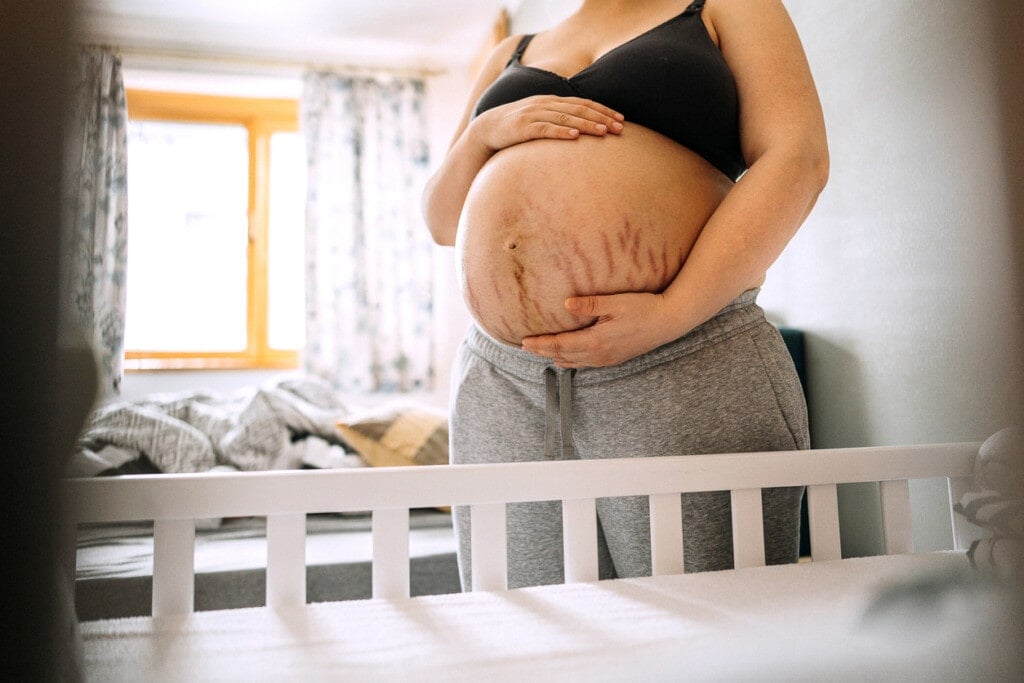Many moms-to-be might dread a few things during their pregnancies. No one wants to have morning sickness or the pains that pregnancy brings. And despite how many women get them, stretch marks are among the most disliked. When the skin stretches, stretch marks will appear, which certainly makes sense as a pregnancy side effect, as women’s bodies often drastically change when pregnant.
Pregnancy stretch marks aren’t always pretty, but they are a natural part of pregnancy that many women experience. However, there are things that you can do to prevent pregnancy stretch marks and help your skin’s overall health.
Stretch Marks are Common for Pregnant Women
Dramatic changes in body size and shape often cause pregnancy stretch marks. But many factors can determine whether you develop them, such as:1
- Being a female
- A family history — if your mom had them, it’s you likely would too
- The pregnancy process
- Rapid growth and changes to the skin
- The use of corticosteroids
- The use of anabolic steroids with exercise
- Having a genetic disorder such as Cushing’s syndrome or Marfan syndrome
Pregnancy Stretch Marks are Not Limited to the Abdomen
Pregnancy stretch marks can develop in many places on the body. The American Pregnancy Association reports that most women seem to develop them on their abdomen during pregnancy and on their breasts, thighs, hips, lower back, and buttocks. Stretch marks during pregnancy are most likely to appear where large amounts of fat are stored. This certainly makes sense, as those areas of the body experience the most changes during pregnancy.2
Pregnancy Stretch Marks Can Appear on Your Body Anytime
Though many women don’t notice pregnancy stretch marks until a couple of months into their pregnancy, there is no real science as to when they will pop up. When they develop, they are typically pink. They may also be itchy and uncomfortable, and the area around the skin may look as though it is flat or thin. As time passes, the stretch marks may get longer and wider, and the color could change to a red or purple tone. As the stretch marks mature, the color fades, and they often appear white or flesh-toned after pregnancy. They may also change shape.2
Can You Prevent Stretch Marks from Appearing?
Some say you can prevent them, and others say no. But there is no reason not to try it through the right foods, exercise, and topical products like oils and lotions. The American Pregnancy Association recommends always keeping your skin as hydrated and soft as possible and eating foods rich in vitamins E and C, zinc, and silica which help form collagen. Other vitamins that might help promote healthy skin include vitamins B2 and B3. You can also exercise to help prevent stretch marks because it helps improve circulation, which keeps the skin elastic and makes it more able to stretch when needed.2
Can You Get Rid of or Reduce Stretch Marks?
Can you eliminate pregnancy stretch marks if you have developed pregnancy marks? They aren’t harmful and may fade over time with or without treatment, but they are unlikely to disappear.1
While there is no sure way to treat pregnancy stretch marks that will make them go away completely, there are methods or products that you can try to reduce the appearance of stretch marks, such as:
- Retinoid cream. This type of topical ointment has been developed from vitamin A, which helps produce collagen. When using a retinoid cream, it may take up to four weeks to notice results and may improve the appearance of stretch marks you’ve only had for a few months. However, always be careful with topical creams and speak to your doctor before you begin this kind of regimen because the cream may affect your baby if you use it while pregnant.1
- Micro-needling. A minimally invasive procedure, micro needling involves using thin needles to make tiny holes in your skin’s top layer. The damage stimulates the skin’s healing, producing more collagen and elastin to help keep your skin firm and smooth.3
- Laser therapy. This skin treatment may be the most effective in reducing pregnancy stretch marks. However, laser therapy can be costly and may take several sessions to achieve the results that you desire.1
You have undoubtedly heard many mothers say, “I’ve earned my tiger stripes,” or “I wear my pregnancy stretch marks like a badge of honor.” And you know what? They are right! Sure, stretch marks may not be the best-looking part of your body, but you can always try to treat them and make them a little less noticeable. But I bet that when you look at your bundle of joy, the last thing you will worry about is a few pregnancy stretch marks. They are a part of life and are absolutely worth it.

































